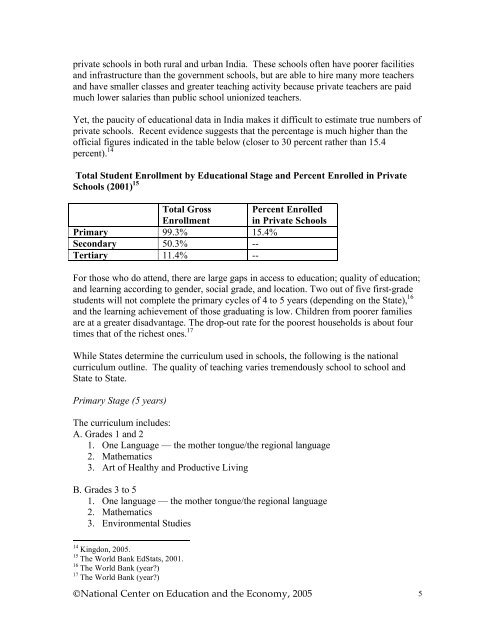India Education Report (2005) - NCEE
India Education Report (2005) - NCEE
India Education Report (2005) - NCEE
Create successful ePaper yourself
Turn your PDF publications into a flip-book with our unique Google optimized e-Paper software.
private schools in both rural and urban <strong>India</strong>. These schools often have poorer facilities<br />
and infrastructure than the government schools, but are able to hire many more teachers<br />
and have smaller classes and greater teaching activity because private teachers are paid<br />
much lower salaries than public school unionized teachers.<br />
Yet, the paucity of educational data in <strong>India</strong> makes it difficult to estimate true numbers of<br />
private schools. Recent evidence suggests that the percentage is much higher than the<br />
official figures indicated in the table below (closer to 30 percent rather than 15.4<br />
percent). 14<br />
Total Student Enrollment by <strong>Education</strong>al Stage and Percent Enrolled in Private<br />
Schools (2001) 15<br />
Total Gross<br />
Enrollment<br />
Percent Enrolled<br />
in Private Schools<br />
Primary 99.3% 15.4%<br />
Secondary 50.3% --<br />
Tertiary 11.4% --<br />
For those who do attend, there are large gaps in access to education; quality of education;<br />
and learning according to gender, social grade, and location. Two out of five first-grade<br />
students will not complete the primary cycles of 4 to 5 years (depending on the State), 16<br />
and the learning achievement of those graduating is low. Children from poorer families<br />
are at a greater disadvantage. The drop-out rate for the poorest households is about four<br />
times that of the richest ones. 17<br />
While States determine the curriculum used in schools, the following is the national<br />
curriculum outline. The quality of teaching varies tremendously school to school and<br />
State to State.<br />
Primary Stage (5 years)<br />
The curriculum includes:<br />
A. Grades 1 and 2<br />
1. One Language — the mother tongue/the regional language<br />
2. Mathematics<br />
3. Art of Healthy and Productive Living<br />
B. Grades 3 to 5<br />
1. One language — the mother tongue/the regional language<br />
2. Mathematics<br />
3. Environmental Studies<br />
14 Kingdon, <strong>2005</strong>.<br />
15 The World Bank EdStats, 2001.<br />
16 The World Bank (year?)<br />
17 The World Bank (year?)<br />
©National Center on <strong>Education</strong> and the Economy, <strong>2005</strong> 5


